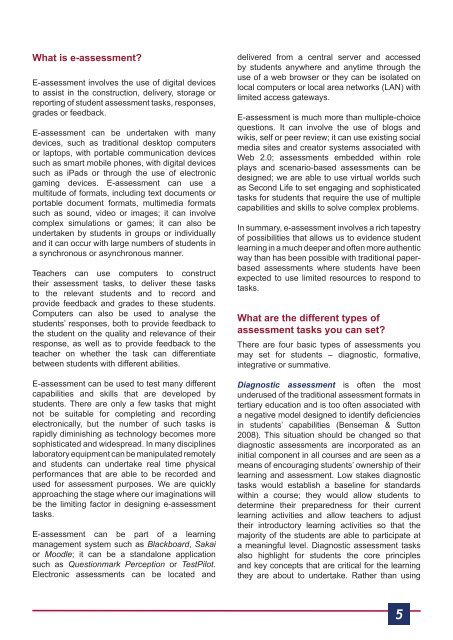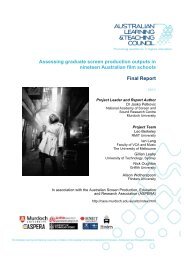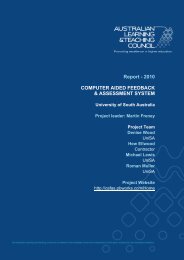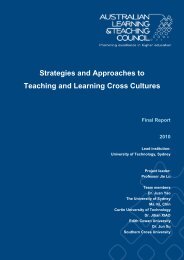Teacher's Handbook on e-Assessment - Office for Learning and ...
Teacher's Handbook on e-Assessment - Office for Learning and ...
Teacher's Handbook on e-Assessment - Office for Learning and ...
Create successful ePaper yourself
Turn your PDF publications into a flip-book with our unique Google optimized e-Paper software.
What is e-assessment<br />
E-assessment involves the use of digital devices<br />
to assist in the c<strong>on</strong>structi<strong>on</strong>, delivery, storage or<br />
reporting of student assessment tasks, resp<strong>on</strong>ses,<br />
grades or feedback.<br />
E-assessment can be undertaken with many<br />
devices, such as traditi<strong>on</strong>al desktop computers<br />
or laptops, with portable communicati<strong>on</strong> devices<br />
such as smart mobile ph<strong>on</strong>es, with digital devices<br />
such as iPads or through the use of electr<strong>on</strong>ic<br />
gaming devices. E-assessment can use a<br />
multitude of <strong>for</strong>mats, including text documents or<br />
portable document <strong>for</strong>mats, multimedia <strong>for</strong>mats<br />
such as sound, video or images; it can involve<br />
complex simulati<strong>on</strong>s or games; it can also be<br />
undertaken by students in groups or individually<br />
<strong>and</strong> it can occur with large numbers of students in<br />
a synchr<strong>on</strong>ous or asynchr<strong>on</strong>ous manner.<br />
Teachers can use computers to c<strong>on</strong>struct<br />
their assessment tasks, to deliver these tasks<br />
to the relevant students <strong>and</strong> to record <strong>and</strong><br />
provide feedback <strong>and</strong> grades to these students.<br />
Computers can also be used to analyse the<br />
students’ resp<strong>on</strong>ses, both to provide feedback to<br />
the student <strong>on</strong> the quality <strong>and</strong> relevance of their<br />
resp<strong>on</strong>se, as well as to provide feedback to the<br />
teacher <strong>on</strong> whether the task can differentiate<br />
between students with different abilities.<br />
E-assessment can be used to test many different<br />
capabilities <strong>and</strong> skills that are developed by<br />
students. There are <strong>on</strong>ly a few tasks that might<br />
not be suitable <strong>for</strong> completing <strong>and</strong> recording<br />
electr<strong>on</strong>ically, but the number of such tasks is<br />
rapidly diminishing as technology becomes more<br />
sophisticated <strong>and</strong> widespread. In many disciplines<br />
laboratory equipment can be manipulated remotely<br />
<strong>and</strong> students can undertake real time physical<br />
per<strong>for</strong>mances that are able to be recorded <strong>and</strong><br />
used <strong>for</strong> assessment purposes. We are quickly<br />
approaching the stage where our imaginati<strong>on</strong>s will<br />
be the limiting factor in designing e-assessment<br />
tasks.<br />
E-assessment can be part of a learning<br />
management system such as Blackboard, Sakai<br />
or Moodle; it can be a st<strong>and</strong>al<strong>on</strong>e applicati<strong>on</strong><br />
such as Questi<strong>on</strong>mark Percepti<strong>on</strong> or TestPilot.<br />
Electr<strong>on</strong>ic assessments can be located <strong>and</strong><br />
delivered from a central server <strong>and</strong> accessed<br />
by students anywhere <strong>and</strong> anytime through the<br />
use of a web browser or they can be isolated <strong>on</strong><br />
local computers or local area networks (LAN) with<br />
limited access gateways.<br />
E-assessment is much more than multiple-choice<br />
questi<strong>on</strong>s. It can involve the use of blogs <strong>and</strong><br />
wikis, self or peer review; it can use existing social<br />
media sites <strong>and</strong> creator systems associated with<br />
Web 2.0; assessments embedded within role<br />
plays <strong>and</strong> scenario-based assessments can be<br />
designed; we are able to use virtual worlds such<br />
as Sec<strong>on</strong>d Life to set engaging <strong>and</strong> sophisticated<br />
tasks <strong>for</strong> students that require the use of multiple<br />
capabilities <strong>and</strong> skills to solve complex problems.<br />
In summary, e-assessment involves a rich tapestry<br />
of possibilities that allows us to evidence student<br />
learning in a much deeper <strong>and</strong> often more authentic<br />
way than has been possible with traditi<strong>on</strong>al paperbased<br />
assessments where students have been<br />
expected to use limited resources to resp<strong>on</strong>d to<br />
tasks.<br />
What are the different types of<br />
assessment tasks you can set<br />
There are four basic types of assessments you<br />
may set <strong>for</strong> students – diagnostic, <strong>for</strong>mative,<br />
integrative or summative.<br />
Diagnostic assessment is often the most<br />
underused of the traditi<strong>on</strong>al assessment <strong>for</strong>mats in<br />
tertiary educati<strong>on</strong> <strong>and</strong> is too often associated with<br />
a negative model designed to identify deficiencies<br />
in students’ capabilities (Benseman & Sutt<strong>on</strong><br />
2008). This situati<strong>on</strong> should be changed so that<br />
diagnostic assessments are incorporated as an<br />
initial comp<strong>on</strong>ent in all courses <strong>and</strong> are seen as a<br />
means of encouraging students’ ownership of their<br />
learning <strong>and</strong> assessment. Low stakes diagnostic<br />
tasks would establish a baseline <strong>for</strong> st<strong>and</strong>ards<br />
within a course; they would allow students to<br />
determine their preparedness <strong>for</strong> their current<br />
learning activities <strong>and</strong> allow teachers to adjust<br />
their introductory learning activities so that the<br />
majority of the students are able to participate at<br />
a meaningful level. Diagnostic assessment tasks<br />
also highlight <strong>for</strong> students the core principles<br />
<strong>and</strong> key c<strong>on</strong>cepts that are critical <strong>for</strong> the learning<br />
they are about to undertake. Rather than using<br />
5

















